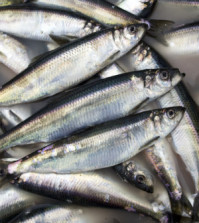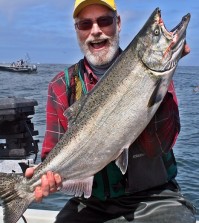Fatal Attractors
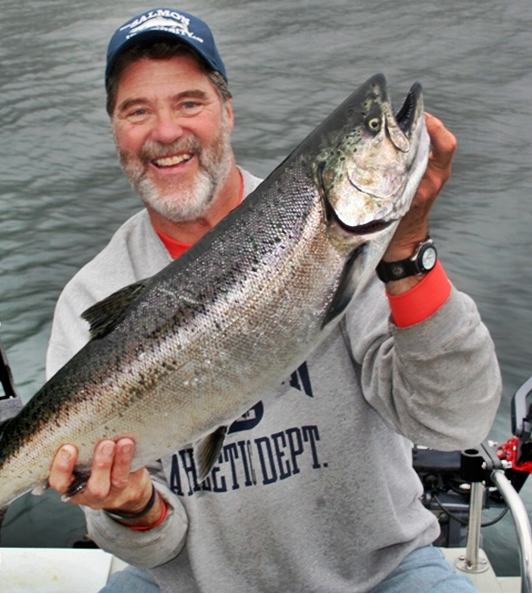
Motor-mooching a plug-cut herring behind a large Spin-n-Glo attractor produced this Sekiu summer chinook. (Terry Rudnick photo)
We’ve all heard that there’s more than one way to skin a cat, and although I don’t know why anyone would really want to do that, the old adage also applies to catching salmon. Take attractors, for example. Most anglers have a good supply of flashers, dodgers and other “traditional” attractors in their salmon-fishing arsenal, and they account for thousands of fish each year, but they’re certainly not the only game in town. There are other options, some considered a little “odd-ball” by many, that work just as well—and perhaps better in certain situations—than the more well-known salmon attractors.
Unlike thousands of my fellow fishermen, I have never caught a steelhead on a Spin-n-Glo, but man, have they helped me catch lots of salmon, in both fresh and salt water. This iconic Yakima Bait product, which has been around nearly as long as I have, can be used in a variety of ways to help draw salmon to your hooks, and it’s one of several lesser-known attractors that can be incorporated into a salmon rig to enhance its effectiveness.
I never really considered using Spin-n-Glos for saltwater salmon until I read a little item on this web site from a British Columbia angler who described using Spin-n-Glo bodies immediately above the plastic squid he fished for winter blackmouth to provide the lure with a little added wiggle and flash, so I went out and bought a few size 12 and size 14 Spin-n-Glos, added them to some of my hoochie rigs and discovered the guy was right. I don’t know how much they helped, but they sure didn’t seem to chase any fish away. Following my success with blackmouth, I tried a few Spin-n-Glo/hoochie rigs for fall Coho, and they worked quite well, too. And, it seemed that larger sizes—8’s, 6’s and even 4’s—worked better than the smaller ones.
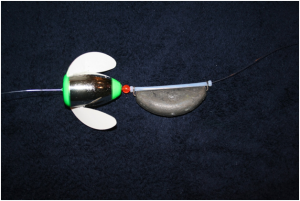
This is how the author rigs a large Spin-n-Glo and Metzler Quick-Change sliding sinker when mooching and motor-mooching for chinook. Not shown is a swivel tied a few inches above the Spin-n-Glo to keep it from sliding up the line while fishing. (Terry Rudnick photo)
For decades I used the traditional sinker-and-plug-cut-herring rig when motor-mooching for summer kings. But lately, especially when fishing first thing in the morning, last thing in the evening, or when fishing especially deep, I slide a special something to the line immediately above the sinker for added visibility. That “something “ is a large Spin-n-Glo body. I started out using the huge size 00 or 000, but I’ve down-sized a little to the size 0 and 2 models. The lure finishes that have worked well for me are those in various shades of chartreuse, green and chrome or combinations of the three, but I wouldn’t hesitate to try the new UV finishes, and I’m sure the luminescent models would be especially good for low-light and deep-water situations. Since motor-mooching is really a combination of trolling and mooching that draws the bait both forward and up and down through the water column as you kick the motor in and out of gear, those big, plastic Spin-n-Glo wings are turning constantly, providing both an audible and visible attraction that helps draw salmon in for a closer look.
The same rig, perhaps with a smaller sinker, is great for trolling when places like Sekiu, Neah Bay, Westport, Willapa Bay and the lower Columbia are loaded with coho. Pink, red, flame and chartreuse Spin-n-Glos seem to work very well for Coho in the upper layers of the column.
Whether you troll or motor-mooch, rig your Spin-n-Glo body on a short (5- or 6-inch) section of line that’s connected to the main line by a ball-bearing or McMahon (barrel) swivel. The swivel not only protects against line twist, but also serves as a stopper to keep the buoyant attractor from sliding up the line and going all the way to the surface, where it would be more of a strike-detector than an attractor.
Another way I use a Spin-n-Glo is as a dummy attractor above my line release when downrigger trolling. As I’ve said before on this web site and other places, I don’t think you can have too much attraction when salmon fishing, so an attractor on the line release, 15 or 20 feet ahead of my bait or lure, can’t possibly hurt. This is where I continue to use the biggest sizes I can get my hands on, usually size 000 or 00. Green and chrome are favorite finishes for this use, but luminescent finishes might be a good bet for trolling especially deep.
No matter how I use a Spin-n-Glo, I add some kind of bead below it that acts as a bearing to allow the lure to spin as freely as possible. A tiny plastic bead is fine when using the smaller sizes, but with the big models I go with a very large bead or a size 8 or 10 Corky body, and I don’t think the bead color matters all that much.
When I bought my first, slightly used, electric downrigger the guy who sold it to me threw in a couple of cannonball weights and some other stuff, including three or four well-used 11-inch flashers, each equipped with a short length of heavy mono and a large snap at its top end. When I asked him why they were rigged that way, he said he liked to trail a flasher behind his downrigger ball, as added attraction to his trolling rig.
That made perfect sense, and with that idea in mind, I started experimenting with new and different ways to attract more salmon to my baits and lures. It soon became apparent that we’re in no way limited to the traditional attractor equipment and techniques if we want to increase the visibility and effectiveness of our fishing systems. The flasher-behind-a-downrigger-ball combination reminded me of something that one of my former bosses had told me a few years before. He said he liked to peruse garage sales in search of fishing tackle bargains, and some of his favorite finds were those large, old-style spinners that salmon anglers used back in the forties and fifties. He polished them up and rigged them behind his downrigger ball in much the same way as the flashers mentioned above.
And, speaking of somewhat older attractors, several years ago Luhr Jensen and Sons put a new model of their Deep Six diver on the market, one that had Mylar wings, and later another that had both Mylar wings and a foot-long Mylar tail. I’ve bought up several of both models over the past few years, and even though they look a little gaudy and sometimes draw snickers and giggles from anglers in nearby boats—and occasionally in my own boat—they work. I think a diver/attractor combination makes perfect sense. Like I said before, you can’t have too much attraction
I’m a long-time fan of Big Al’s Fish Flash (now a part of Yakima Bait’s expansive line of salmon tackle), and after using them a couple of years I began to experiment with snapping two of them together in tandem for increased visibility in dirty water or low-light conditions. When the small (6-inch) model was added to the Fish Flash line, I found that using two of them in different colors ahead of a whole or plug-cut herring was a very effective trolling rig. I have also used two (and sometimes three) Fish Flashes of various sizes strung together and snapped onto a short length of heavy mono behind my downrigger ball on several occasions, usually with good results.
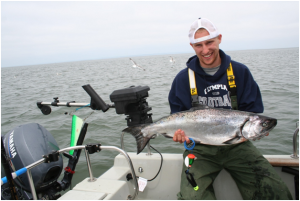
The author’s downrigger gear includes a Silver Horde/Gold Star Rudder Flasher (hanging off the downrigger at left) and a size 000 Spin-n-Glo above the line-release clip. A Coho Killer fished with these added attractors fooled this 11-pound chinook for Dillon Reed of Olympia. (Terry Rudnick photo)
KoneZone flashers, which resemble a Fish Flash with rounded corners, are also popular among Northwest salmon anglers, and the KoneZone folks make a pre-rigged “dummy” attractor string that consists of four flashers, one each in a 4-inch, 6-inch, 7 ½-inch and 9-inch model. Called the KoneZone B.C. Daisy Chain, it’s made to be fished on a downrigger wire a short distance below the line release.
Another form of attractor that I now use on all of my downriggers is the Gold Star/Silver Horde Rudder Flasher. Originally intended as a halibut spreader, what’s now known as the Rudder Flasher is a sheet of metal, cut into an elongated triangle, with a swivel at each corner. It can be rigged two or three different ways to serve as an attractor (and rudder) on downrigger gear, but I just snap it to the wire immediately above the weight snubber and attach my release line to the back (narrow) end. Although it doesn’t wiggle or rotate in the water to produce a lot of audible attraction, it has much more surface area than any flasher or dodger, so it adds a great deal of visible attraction a few yards ahead of whatever bait or lure you’re towing through the water. It’s available in several finishes, including a number of luminescent combinations. First thing in the morning or in the fading light of evening, I use the luminescent finishes and charge them up with a flashlight whenever I bring the rig to the surface. When I’m fishing shallow and/or in bright sunshine I often exchange the luminescent Rudder Flashers for the chrome ones to get more flash and shine.
So, even if you’re a big flasher fan, dodger die-hard or favor the Fish Flash, don’t be afraid to experiment a little with other attractor options. You just might be surprised.



